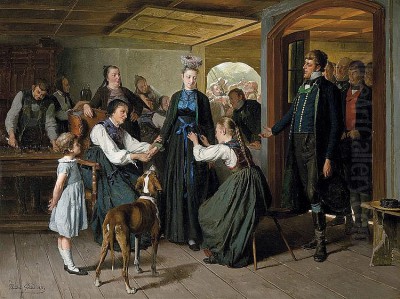
Theodore Gerard stands as a notable figure in nineteenth-century Belgian art, an artist whose work captured the charm and character of rural life and historical settings. Born in the historic city of Ghent in 1829 and passing away in 1895, Gerard dedicated his career to the meticulous and often affectionate depiction of everyday scenes, primarily focusing on the peasantry and village life of the Low Countries. His paintings offer a window into a world that was rapidly changing, preserving moments of domesticity, work, and leisure with considerable skill and sensitivity.
While sometimes overshadowed by the more revolutionary artistic movements that emerged during his lifetime, Gerard's contributions to the tradition of genre painting remain significant. He operated within a rich artistic environment in Belgium, a nation forging its identity and fostering a vibrant cultural scene throughout the nineteenth century. Understanding Gerard requires placing him within this context, appreciating both his adherence to established traditions and his subtle engagement with the evolving artistic landscape.
Early Life and Artistic Formation in Ghent
Theodore Gerard's journey as an artist began in Ghent, a city with a long and distinguished artistic heritage, home to masters like the Van Eyck brothers centuries earlier. It was here, amidst the echoes of Flanders' Golden Age, that Gerard received his foundational artistic training. He enrolled at the Ghent Academy, a key institution for nurturing artistic talent in the region. Academic training during this period was rigorous, emphasizing drawing from casts and live models, studying anatomy, and mastering perspective and composition according to classical principles.
The specific mentors who guided Gerard during his formative years at the Ghent Academy are not widely documented in accessible historical records. This lack of detailed information regarding his teachers is not uncommon for artists of his era who did not achieve the very highest echelons of fame or notoriety. However, the curriculum itself would have provided a strong grounding in technical proficiency. This academic foundation is evident in the careful construction and detailed rendering found in his later works. Unlike artists who might have pursued a more independent or apprenticeship-based path, Gerard's formal education shaped his approach to painting.
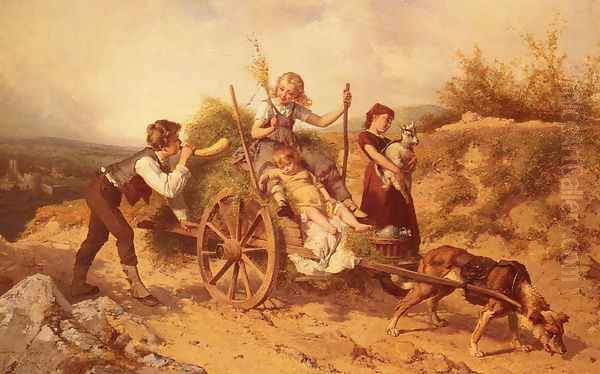
His time in Ghent provided him not only with technical skills but likely also with his initial exposure to the subjects that would dominate his career. The surrounding countryside and the lives of its inhabitants offered a wealth of inspiration, a theme deeply rooted in Flemish and Dutch art history, harking back to painters like Pieter Bruegel the Elder and David Teniers the Younger, whose depictions of peasant life were foundational.
Development in Brussels and Broadening Horizons
After his initial training in Ghent, Theodore Gerard, like many ambitious artists of his time, gravitated towards Brussels. The capital city had firmly established itself as the political, economic, and cultural heart of the relatively young nation of Belgium. It offered a larger, more dynamic art market, greater opportunities for patronage, and a stimulating environment where artists could interact, compete, and exhibit their work. Establishing a career in Brussels was a crucial step for Gerard to gain wider recognition.
His artistic development was further enriched by travel. Records indicate that Gerard journeyed through parts of Germany and Austria-Hungary. Such travels were considered essential for artists seeking to broaden their perspectives, observe different landscapes and cultures, and study the works of masters housed in foreign collections. Exposure to different artistic traditions, even if his own style remained focused, could subtly influence palette, composition, or thematic choices. These experiences likely provided fresh subject matter or new ways of seeing the familiar scenes of his homeland.
The decision to base himself in Brussels while undertaking international travel reflects a common pattern for successful nineteenth-century artists. It allowed them to maintain a connection to their national identity and market while participating in a broader European artistic dialogue. This period was crucial for honing his craft and defining his niche within the bustling art scene.
Artistic Style: Genre Painting and Subtle Influences
Theodore Gerard is primarily identified as a genre painter. This category encompasses scenes of everyday life, typically featuring ordinary people engaged in common activities. Gerard excelled in depicting intimate domestic interiors, village gatherings, children at play, and moments of rural labour or leisure. His approach was generally characterized by careful observation, a high degree of finish, and a narrative quality, inviting viewers to piece together the story within the frame.
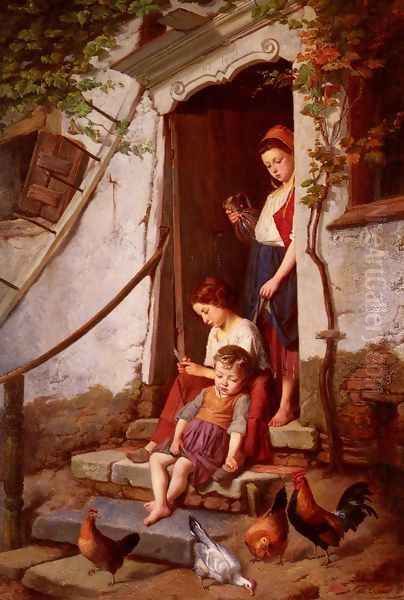
His works often possess a warmth and charm, focusing on the picturesque aspects of peasant life rather than the harsh realities often highlighted by Realist painters like his French contemporary Jean-François Millet or fellow Belgian Constantin Meunier, who focused on the struggles of industrial labourers. Gerard's peasants are usually content, his interiors cozy, and his children endearing. This aligns with a significant segment of the nineteenth-century art market, which favoured pleasant, easily understandable, and often nostalgic scenes.
Some sources suggest influences from Impressionism or Post-Impressionism on Gerard's style. This claim requires careful consideration. While Gerard was active during the rise of these movements, his core style remained largely rooted in the detailed, narrative tradition of academic genre painting. It is unlikely he fully embraced the Impressionists' revolutionary techniques – their emphasis on capturing fleeting moments of light with broken brushwork and a focus on optical sensation over narrative detail.
However, it's plausible that, like many artists of his time, Gerard may have subtly adapted his palette, perhaps incorporating brighter colours than earlier genre painters, or occasionally employed slightly looser brushwork in certain areas, reflecting a general shift in artistic sensibilities influenced by the plein-air movement and Impressionism. Yet, his primary commitment remained to detailed rendering and anecdotal clarity, distinguishing his work from true Belgian Impressionists like Emile Claus or Luminists such as Théo van Rysselberghe. His style sits more comfortably alongside other Belgian genre specialists, perhaps showing an evolution from the meticulousness of earlier figures like Henri de Braekeleer.
Key Themes: The Fabric of Rural Life
The recurring themes in Theodore Gerard's oeuvre revolve around the depiction of Belgian rural and village life. He demonstrated a particular fondness for portraying children, capturing their games, interactions, and expressions with sympathy and charm. Works like The Country Children and The Farmers Children likely exemplify this focus, presenting idealized yet engaging visions of childhood innocence within a rustic setting.
Domestic interiors form another significant part of his work. He often depicted families gathered in simple cottages, engaged in activities like meals, conversations, or quiet tasks. These scenes emphasize familial bonds and the rhythms of daily life. The attention to detail in rendering furniture, clothing, and household objects adds to the authenticity and narrative richness of these paintings. Titles such as The New Rattle suggest a focus on specific, relatable moments within the domestic sphere – perhaps the introduction of a new toy to an infant, a scene brimming with potential for depicting parental affection and infant curiosity.
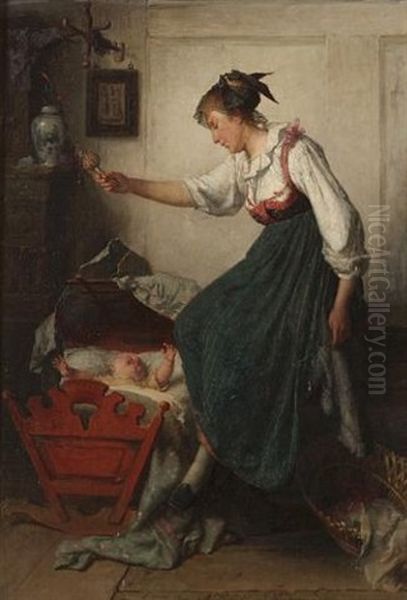
Historical costume pieces also feature in his output. While still often set within a genre context, these works allowed Gerard to explore different textures, colours, and historical details, appealing to a taste for the picturesque and the historical past. This interest connected him to a broader nineteenth-century fascination with history, seen in the grander historical paintings of artists like Hendrik Leys or Nicaise de Keyser in Belgium, though Gerard's focus remained on the more intimate, everyday aspects even within historical settings.
The overall impression conveyed by Gerard's thematic choices is one of gentle nostalgia and an appreciation for the enduring qualities of community, family, and simple pleasures. His work largely avoided overt social commentary or political engagement, preferring instead to celebrate the perceived stability and charm of traditional ways of life.
Notable Works and Recognition
Several specific titles help illustrate the nature of Theodore Gerard's artistic production. The New Rattle, The Unwanted Guest, The Center of Attention, The Country Children, and The Farmers Children all point towards his engagement with domestic narratives and the lives of rural families, particularly children. The Unwanted Guest, for instance, likely depicts a humorous or slightly awkward social encounter within a cottage setting, a common trope in genre painting allowing for the exploration of varied human expressions and interactions. The Center of Attention might focus on a specific individual – perhaps a child, a storyteller, or a musician – capturing the dynamics of a small community gathering.
A particularly noteworthy painting is 59 Children Playing with a Lamb. The title itself is somewhat unusual ("59" might be a specific inventory or exhibition number rather than a literal count within the scene, or perhaps an error in transcription over time; typically, genre scenes feature fewer figures unless depicting large festivities). Regardless of the exact title interpretation, a scene of children playing with a lamb is archetypal genre subject matter, evoking innocence and pastoral harmony.
The significance of this particular work is underscored by its exhibition history and patronage. It was shown in both Brussels and London, indicating Gerard's reach beyond Belgium's borders. Crucially, it was purchased by the Queen of the Belgians. Royal patronage was a significant mark of success and prestige for an artist in the nineteenth century. It not only provided financial reward but also considerably boosted the artist's reputation and desirability among other collectors.
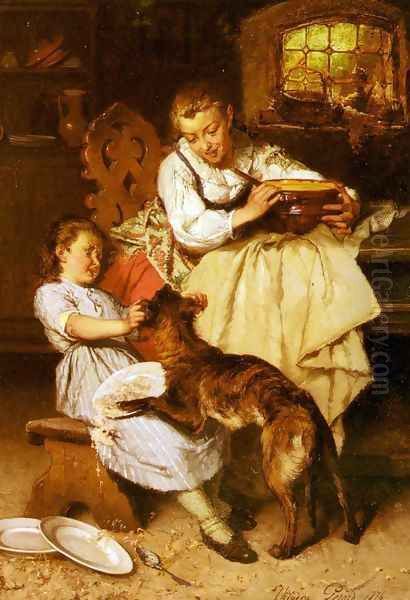
Furthermore, Gerard achieved recognition through the established Salon system. He exhibited his works regularly, and his success is evidenced by the fact that he was awarded medals at exhibitions in Brussels. Salons were the primary venues for artists to display their work to the public, critics, and potential buyers. Winning an award at a major Salon was a critical validation of an artist's skill and standing within the art community.
Context: Belgian Art in the Nineteenth Century
To fully appreciate Theodore Gerard's place, it's essential to view him within the vibrant and diverse landscape of nineteenth-century Belgian art. Following its independence in 1830, Belgium experienced a period of intense nation-building, which included fostering a distinct national artistic identity. This led to significant state support for the arts and the flourishing of academies in Brussels, Antwerp, and Ghent.
The century saw a succession and overlap of various artistic styles. Historical painting, often celebrating glorious moments from the nation's past, was prominent early on, championed by figures like Gustaf Wappers, Nicaise de Keyser, and Hendrik Leys. Gerard's occasional historical costume pieces connect loosely to this tradition, albeit on a more intimate scale.
Realism gained significant traction mid-century, with artists seeking to depict contemporary life with unflinching honesty. Constantin Meunier became internationally renowned for his powerful sculptures and paintings of miners and industrial workers, while Charles de Groux focused on the lives of the urban poor and peasantry with sober empathy. Gerard's focus on rural life aligns him broadly with Realist interests in contemporary subjects, but his tendency towards idealization and picturesque charm distinguishes him from the often harsher or more socially critical approach of Meunier or De Groux.
Later in the century, Belgium became an important center for Impressionism and its variants (often termed 'Luminism' in Belgium), with Emile Claus as a leading figure capturing the effects of light on the Flanders landscape. Simultaneously, Symbolism found fertile ground, producing highly imaginative and introspective works by artists like Fernand Khnopff and James Ensor. The avant-garde group Les XX (Les Vingt), founded in Brussels in 1883, became a major international forum for progressive art, exhibiting works by Belgian innovators alongside international figures like Georges Seurat and Vincent van Gogh.
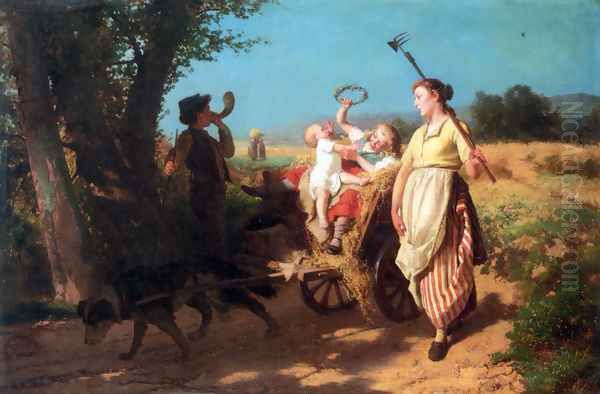
Gerard operated somewhat parallel to these more avant-garde developments. His adherence to genre painting placed him within a more traditional, yet still highly popular and commercially viable, stream of Belgian art. His contemporaries in genre might include Henri de Braekeleer, known for his meticulously rendered Antwerp interiors, though De Braekeleer's work often possesses a more profound psychological depth. Gerard's work provided a comforting counterpoint to both the starkness of Realism and the radical experiments of Impressionism and Symbolism, catering to a bourgeois taste for well-crafted, narrative scenes. His international context includes artists like the French Barbizon school painters (though they focused more on landscape) and genre painters across Europe, such as Eastman Johnson in America or Wilhelm Leibl in Germany, who also chronicled aspects of rural and everyday life.
Addressing Discrepancies and Gaps in the Record
When researching Theodore Gerard, some conflicting or incomplete information emerges, which warrants clarification. Notably, some sources encountered during research mistakenly associate the name Theodore Gerard with a career in music, specifically as a cellist in a modern orchestra. This appears to be a clear case of mistaken identity, confusing the nineteenth-century painter with a contemporary musician of the same or similar name. All credible art historical sources confirm that Theodore Gerard (1829-1895) was unequivocally a Belgian painter specializing in genre scenes.
Furthermore, compared to some of his more famous contemporaries, the historical record regarding Gerard's personal life seems relatively sparse. Specific anecdotes, detailed accounts of his personality, extensive lists of students or close artistic collaborators, information about his specific social circles within the Brussels art scene, or involvement in any notable controversies are not readily available in standard biographical sources.
This lack of information does not necessarily diminish his significance as an artist but perhaps reflects the nature of his career. He may have been a private individual focused primarily on his work and family, less inclined towards the public persona cultivation seen in some other artists. Alternatively, it could simply be that historical documentation has been lost or remains uncatalogued. His success, marked by exhibitions, awards, and royal patronage, confirms his standing during his lifetime, even if the more colourful details of his biography remain elusive. The focus, therefore, must remain on the tangible evidence: his paintings and their place within nineteenth-century art.
Later Life and Legacy
Theodore Gerard continued to paint until his death in 1895. His career spanned a period of significant artistic transformation in Europe, yet he remained largely faithful to the genre tradition that he mastered early on. While the avant-garde movements of Impressionism, Post-Impressionism, and Symbolism increasingly captured critical attention towards the end of the century, there remained a consistent market and appreciation for the kind of well-executed, engaging genre scenes that Gerard produced.
His legacy is that of a skilled and sensitive chronicler of Belgian rural life. His paintings offer valuable visual documents of the customs, clothing, and environments of the communities he depicted. While perhaps not an innovator in the mold of Ensor or Khnopff, Gerard represents an important aspect of nineteenth-century Belgian art – the continuation and adaptation of the rich Flemish and Dutch tradition of genre painting. His work resonated with contemporary audiences, providing charming, relatable, and often idealized glimpses into the everyday world.
Today, his paintings can be found in various Belgian museums and private collections. They continue to be appreciated for their technical accomplishment, narrative charm, and historical interest. For art historians, Gerard's work provides insight into the tastes and values of the period, illustrating the enduring appeal of genre painting even amidst the rise of modernism. He remains a testament to the diversity of artistic practice in nineteenth-century Belgium, a competent and respected artist who successfully carved out a niche for himself through the careful observation and affectionate portrayal of his chosen subjects.
Conclusion: A Painter of Place and People
Theodore Gerard occupies a solid, if not always spotlighted, position in the history of Belgian art. As a product of the Ghent Academy and a professional active primarily in Brussels, he was firmly embedded in the artistic structures of his time. His travels broadened his experience, but his artistic heart remained in the depiction of the familiar – the cottages, villages, and people of the Belgian countryside.
His commitment to genre painting, with its focus on narrative, detail, and relatable human situations, ensured his popularity during his lifetime, evidenced by exhibitions, awards, and prestigious patronage. While not a revolutionary, he adapted his academic training to create works of enduring charm and warmth. His paintings of children, families, and rural gatherings, alongside occasional forays into historical costume, capture a specific facet of nineteenth-century life and artistic taste.
Though lacking the extensive biographical anecdotes or documented controversies of some contemporaries, and sometimes subject to misinformation regarding his profession, Theodore Gerard's identity as a skilled Belgian painter is clear. His work stands as a valuable contribution to the genre tradition, offering a window onto the everyday world of nineteenth-century Belgium through the eyes of an observant and sympathetic artist. He remains a figure worthy of attention for anyone interested in the rich tapestry of European art during this transformative period.